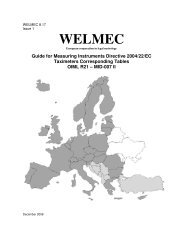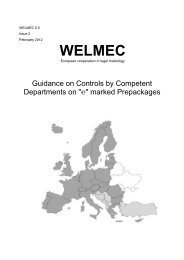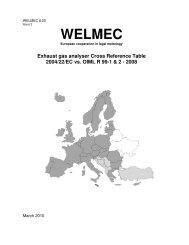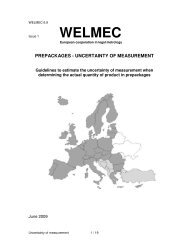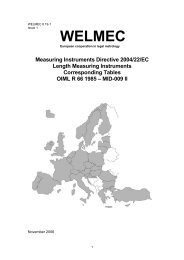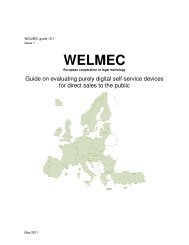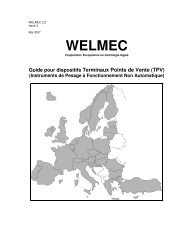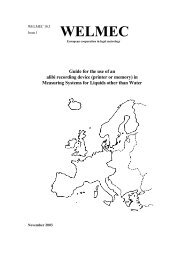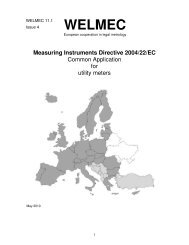Guide on Directive 75/107/EEC Measuring Container ... - WELMEC
Guide on Directive 75/107/EEC Measuring Container ... - WELMEC
Guide on Directive 75/107/EEC Measuring Container ... - WELMEC
You also want an ePaper? Increase the reach of your titles
YUMPU automatically turns print PDFs into web optimized ePapers that Google loves.
<strong>WELMEC</strong> 6.12Issue 1February 2013<strong>WELMEC</strong>European Cooperati<strong>on</strong> in Legal Metrology<str<strong>on</strong>g>Guide</str<strong>on</strong>g> <strong>on</strong> <strong>Directive</strong> <strong>75</strong>/<strong>107</strong>/<strong>EEC</strong><strong>Measuring</strong> C<strong>on</strong>tainer Bottles
<strong>WELMEC</strong> 6.12, Issue 1: <str<strong>on</strong>g>Guide</str<strong>on</strong>g> <strong>on</strong> <strong>Directive</strong> <strong>75</strong>/<strong>107</strong>/<strong>EEC</strong> <strong>Measuring</strong> C<strong>on</strong>tainer Bottles<strong>WELMEC</strong>European Cooperati<strong>on</strong> in Legal Metrology<strong>WELMEC</strong> is a co-operati<strong>on</strong> between the legal metrology authorities ofthe Member States of the European Uni<strong>on</strong> and EFTA.This document is <strong>on</strong>e of a number of <str<strong>on</strong>g>Guide</str<strong>on</strong>g>s published by <strong>WELMEC</strong> toprovide guidance to packers, importers and the Competent Departmentsresp<strong>on</strong>sible for ensuring the prepackages meet the specifiedrequirements.The <str<strong>on</strong>g>Guide</str<strong>on</strong>g>s are purely advisory and do not themselves impose anyrestricti<strong>on</strong>s or additi<strong>on</strong>al technical requirements bey<strong>on</strong>d those c<strong>on</strong>tainedin relevant EU <strong>Directive</strong>s.Alternative approaches may be acceptable, but the guidance providedin this document represents the c<strong>on</strong>sidered view of <strong>WELMEC</strong> as to thebest practice to be followed.Published by:<strong>WELMEC</strong> SecretariatE-mail: secretary@welmec.orgWebsite: www.welmec.orgPage 2 of 28
<strong>WELMEC</strong> 6.12, Issue 1: <str<strong>on</strong>g>Guide</str<strong>on</strong>g> <strong>on</strong> <strong>Directive</strong> <strong>75</strong>/<strong>107</strong>/<strong>EEC</strong> <strong>Measuring</strong> C<strong>on</strong>tainer BottlesC<strong>on</strong>tents1 Introducti<strong>on</strong> ........................................................................................................................ 42 Scope ................................................................................................................................ 53 Free movement of MCB ..................................................................................................... 64 Technical Requirements .................................................................................................... 65 Approval of Marks .............................................................................................................. 86 Indicati<strong>on</strong>s ......................................................................................................................... 87 Resp<strong>on</strong>sibilities ............................................................................................................... 118 Reference Method ........................................................................................................... 129 Use of MCB in Making up Prepackages .......................................................................... 1410 Certificati<strong>on</strong> of a Templet ................................................................................................. 1411 Example: MCB and Templet C<strong>on</strong>trol................................................................................ 16Annex 1 The Reversed Epsil<strong>on</strong> Mark ............................................................................... 18Annex 2 Example of Manufacturer’s Checks .................................................................... 19Annex 3 Methods of Manufacture .................................................................................... 20Annex 4 Example of a templet used for m<strong>on</strong>itoring the volume of product in an MCB ...... 22Annex 5 Competent Departments C<strong>on</strong>tact Details ........................................................... 23Page 3 of 28
<strong>WELMEC</strong> 6.12, Issue 1: <str<strong>on</strong>g>Guide</str<strong>on</strong>g> <strong>on</strong> <strong>Directive</strong> <strong>75</strong>/<strong>107</strong>/<strong>EEC</strong> <strong>Measuring</strong> C<strong>on</strong>tainer Bottles1 Introducti<strong>on</strong>1.1. <strong>WELMEC</strong> Working Group 6 (WG 6) was set up to discuss, and propose soluti<strong>on</strong>s for, theproblems associated with the trading of prepackaged products between EEA countries.It was decided that a set of documents for inspectors, which could be used by CompetentDepartments (a list of Competent Departments is seen in Annex 5) in all EEA countries,should be produced. The intenti<strong>on</strong> of the documents is to achieve a uniform level ofenforcement.1.2. This document is part of a series of documents published by <strong>WELMEC</strong>, which are primarilyintended to provide guidance to all those c<strong>on</strong>cerned with the applicati<strong>on</strong> of <strong>Directive</strong>s76/211/<strong>EEC</strong> and 2007/45/EC for prepacked products. The documents are intendedto lead to a uniform interpretati<strong>on</strong> and enforcement of these directives and assist in theremoval of barriers to trade.Documents agreed by <strong>WELMEC</strong> are published <strong>on</strong> their website athttp://www.welmec.org/latest/guides.html6.0 Introducti<strong>on</strong> to <strong>WELMEC</strong> documents <strong>on</strong> prepackages6.1 Definiti<strong>on</strong>s of terms6.3 Guidance for the Harm<strong>on</strong>ised Implementati<strong>on</strong> of Council <strong>Directive</strong>76/211/<strong>EEC</strong> as amended6.4 <str<strong>on</strong>g>Guide</str<strong>on</strong>g> for packers and importers of ‘℮’ marked prepacked products6.5 Guidance <strong>on</strong> C<strong>on</strong>trols by Competent Departments6.6 <str<strong>on</strong>g>Guide</str<strong>on</strong>g> for recogniti<strong>on</strong> of procedures6.7 <str<strong>on</strong>g>Guide</str<strong>on</strong>g> for Market C<strong>on</strong>trol <strong>on</strong> Prepackages for Competent Departments6.8 Guidance for the Verificati<strong>on</strong> of Drained Weight6.9 Prepackages - Uncertainty of Measurement6.10 Informati<strong>on</strong> <strong>on</strong> C<strong>on</strong>trols <strong>on</strong> Prepacked Products6.11 Prepackages whose Quantity Changes after Packing6.12 <str<strong>on</strong>g>Guide</str<strong>on</strong>g> <strong>on</strong> <strong>Directive</strong> <strong>75</strong>/<strong>107</strong>/<strong>EEC</strong> - <strong>Measuring</strong> C<strong>on</strong>tainer Bottles1.3. <strong>Directive</strong> 76/211/<strong>EEC</strong> states 1 “In the case of products in quantities expressed in units ofvolume, <strong>on</strong>e of several methods of meeting the measuring and checking requirements isto use, when making up the prepackage, a measuring c<strong>on</strong>tainer of the type defined inthe <strong>Directive</strong> relating thereto, filled under the c<strong>on</strong>diti<strong>on</strong>s prescribed in that <strong>Directive</strong> andherein”.1.4. The relevant <strong>Directive</strong> is “Council <strong>Directive</strong> <strong>75</strong>/<strong>107</strong>/<strong>EEC</strong> of 19 December 1974 <strong>on</strong> theapproximati<strong>on</strong> of the laws of the Member States relating to bottles used as measuringc<strong>on</strong>tainers“. In this document this <strong>Directive</strong> is referred to as the <strong>Directive</strong>. <strong>Measuring</strong>c<strong>on</strong>tainer bottles are referred to as MCB.1.5. This document is intended to give guidance to manufacturers of MCB and authoritiesresp<strong>on</strong>sible for ensuring compliance with the requirements of the <strong>Directive</strong> and how theycan be met. The document also c<strong>on</strong>siders the Internati<strong>on</strong>al Organisati<strong>on</strong> for Legal Metrology’srecommendati<strong>on</strong> 2 for MCB.1 <strong>Directive</strong> 76/211/<strong>EEC</strong>, Annex I, 4, last paragraph.2 OIML R138, 2007(E), “Vessels for Commercial Transacti<strong>on</strong>s”.Page 4 of 28
<strong>WELMEC</strong> 6.12, Issue 1: <str<strong>on</strong>g>Guide</str<strong>on</strong>g> <strong>on</strong> <strong>Directive</strong> <strong>75</strong>/<strong>107</strong>/<strong>EEC</strong> <strong>Measuring</strong> C<strong>on</strong>tainer Bottles2 Scope2.1. The <strong>Directive</strong> defines a ‘measuring c<strong>on</strong>tainer bottle’ as a bottle 3 :- made of glass or other rigid and stable substance,- designed to be stoppered, and intended for storage, transport or delivery of liquids,- having a Nominal Capacity between 0.05 l and 5 l inclusive,- that can be measured with sufficient accuracy, when filled to a specified level orspecified percentage of their Brim Capacity.The Nominal Capacity and the Brim Capacity are defined in Secti<strong>on</strong> 4.1.2.2. Bottles that are not covered by the <strong>Directive</strong> include bottles:- made of flexible materials, such as thin plastic material,- that are not designed to be capped or stoppered,- used for n<strong>on</strong>-liquid products, such as thick sauces,- with a Nominal Capacity less than 50 ml or more than 5 l,- that are not manufactured to measure with sufficient accuracy.2.3. MCB that are ‘3’ marked have to 4 :- meet the requirements of the <strong>Directive</strong>, and- be subject to metrological c<strong>on</strong>trol specified in the Annexes 5 .2.4. MCB are permitted, by <strong>Directive</strong> 76/211/<strong>EEC</strong>, to be used when making up prepackages,where the quantity is expressed in units of volume, when filled to the appropriate filllevel 6 .2.5. There is no prohibiti<strong>on</strong> <strong>on</strong> the manufacture of n<strong>on</strong> ‘3’ marked MCB, and any produced d<strong>on</strong>ot have to meet the requirements nor be subject to metrological c<strong>on</strong>trols. These bottlescannot be used as measures for the purposes of <strong>Directive</strong> 76/211/<strong>EEC</strong>. Methods ofmanufacture are described in Annex 3.3 <strong>Directive</strong> <strong>75</strong>/<strong>107</strong>/<strong>EEC</strong>, Article 1.4 A reversed epsil<strong>on</strong>, the EC sign indicating an exempti<strong>on</strong> from pattern approval prescribed in Annex I, 6.3 of <strong>Directive</strong>2009/34/EC. An example of this sign is seen in Annex 1 of this document.5 <strong>Directive</strong> <strong>75</strong>/<strong>107</strong>/<strong>EEC</strong>, Article 2.6 <strong>Directive</strong> 76/211/<strong>EEC</strong>, Annex I, 4, last paragraph.Page 5 of 28
<strong>WELMEC</strong> 6.12, Issue 1: <str<strong>on</strong>g>Guide</str<strong>on</strong>g> <strong>on</strong> <strong>Directive</strong> <strong>75</strong>/<strong>107</strong>/<strong>EEC</strong> <strong>Measuring</strong> C<strong>on</strong>tainer Bottles3 Free movement of MCB3.1. No Member State may refuse, prohibit or restrict the marketing and use of MCB whichsatisfy the requirements and tests specified in the <strong>Directive</strong> for reas<strong>on</strong>s c<strong>on</strong>cerning 7 :- their volume,- the determinati<strong>on</strong> of their volume, or- the methods by which they have been checked.3.2. N<strong>on</strong> ‘3’ marked MCB are not given free movement by the <strong>Directive</strong>, although subsequentEuropean legislati<strong>on</strong> indicates that this should be allowed except for certain stated reas<strong>on</strong>s8 .4 Technical Requirements4.1. The technical requirements are c<strong>on</strong>tained in Annex I of the <strong>Directive</strong> which commenceswith the definiti<strong>on</strong> of terms relating to the capacity of the MCB at a standard temperatureof 20 °C. The technical requirements are 9 :- the Nominal Capacity, V n , is the volume which is marked <strong>on</strong> the bottle. It is thevolume of liquid which the MCB is deemed to c<strong>on</strong>tain when it is filled in the c<strong>on</strong>diti<strong>on</strong>sof use for which it is intended,- the Brim Capacity of a bottle, is the volume of liquid it c<strong>on</strong>tains when filled to thebrim, and- the Actual Capacity of a bottle, is the volume of liquid it in fact c<strong>on</strong>tains when it isfilled exactly under the c<strong>on</strong>diti<strong>on</strong>s corresp<strong>on</strong>ding theoretically to the Nominal Capacity.4.2. The <strong>Directive</strong> recognises that there are two methods of filling bottles, which are 10 :- filling to a c<strong>on</strong>stant level, where liquid is introduced and the MCB is filled up tothe stated fill height, and- filling to a c<strong>on</strong>stant vacuity, where the MCB is filled to the brim and then a specificquantity is removed.4.3. The <strong>Directive</strong> goes <strong>on</strong> to require 11 that the manufacture of the MCB should be such toensure that the distance between the theoretical filling level for the Nominal Capacityand the brim level and the difference between the Brim Capacity and Nominal Capacity,shall be perceptibly c<strong>on</strong>stant for all MCB of the same type, that is for all MCB made tothe same design.4.4. It is recognised that there will be variati<strong>on</strong>s in manufacture and there is a need for sufficientaccuracy in order to meet the <strong>Directive</strong> 76/211/<strong>EEC</strong> requirements for prepackages,so the <strong>Directive</strong> specifies the maximum permissible errors (both positive and negative) 12 .These errors are seen in Table 1.7 <strong>Directive</strong> <strong>75</strong>/<strong>107</strong>/<strong>EEC</strong>, Article 3.8 For instance Regulati<strong>on</strong> (EC) 764/2008 relating to the applicati<strong>on</strong> of certain nati<strong>on</strong>al technical rules to products lawfullymarketed in another Member State.9 <strong>Directive</strong> <strong>75</strong>/<strong>107</strong>/<strong>EEC</strong>, Annex I, 1.10 <strong>Directive</strong> <strong>75</strong>/<strong>107</strong>/<strong>EEC</strong>, Annex I, 2.11 <strong>Directive</strong> <strong>75</strong>/<strong>107</strong>/<strong>EEC</strong>, Annex I, 2, last paragraph.12 <strong>Directive</strong> <strong>75</strong>/<strong>107</strong>/<strong>EEC</strong>, Annex I 3.Page 6 of 28
<strong>WELMEC</strong> 6.12, Issue 1: <str<strong>on</strong>g>Guide</str<strong>on</strong>g> <strong>on</strong> <strong>Directive</strong> <strong>75</strong>/<strong>107</strong>/<strong>EEC</strong> <strong>Measuring</strong> C<strong>on</strong>tainer BottlesNote that the maximum permissible errors given in Table 1 are not valid for a singleMCB, but are used to calculate T s and T i 13 when carrying out a reference test accordingto Annex II of the <strong>Directive</strong>.Table 1: Maximum Permissible ErrorsNominal Capacity, V n , in millilitres Maximum permissible errorsas a % of V n in millilitresfrom 50 to 100 - 3from 100 to 200 3 -from 200 to 300 - 6from 300 to 500 2 -from 500 to 1 000 - 10from 1 000 to 5 000 1 -4.5. The <strong>Directive</strong> states in Annex I, 3, last paragraph, that the systematic exploitati<strong>on</strong> of tolerancesshall be prohibited. <strong>WELMEC</strong> WG 6 recommends, that if the regular checksshow an average volume of the MCB that differ from the Nominal Capacity of the MCB,the manufacturer shall (if possible) take the necessary measures to bring the producti<strong>on</strong>closer to the Nominal Capacity of the bottle.It is good practice for the manufacturer to inform the packer about the average capacityof each batch of MCB, especially when it is not possible to take the necessary measuressuggested above.4.6. The practical determinati<strong>on</strong> of the Actual Capacity of the MCB can be made by 14 :- measuring the quantity of water at 20 °C which the MCB actually c<strong>on</strong>tains whenfilled to the level theoretically corresp<strong>on</strong>ding to the Nominal Capacity, or- a method of equivalent accuracy.4.7. The latter would permit weighing the quantity of a liquid of known density needed to fillthe MCB to the required level, and determining the volume by dividing this weight by thedensity, using equipment of appropriate accuracy. See <strong>WELMEC</strong> document 6.9 “Prepackages– Uncertainty of Measurement” for assessing the suitability of equipment.13 <strong>Directive</strong> <strong>75</strong>/<strong>107</strong>/<strong>EEC</strong>, Annex II, 3.14 <strong>Directive</strong> <strong>75</strong>/<strong>107</strong>/<strong>EEC</strong>, Annex I, 4.Page 7 of 28
<strong>WELMEC</strong> 6.12, Issue 1: <str<strong>on</strong>g>Guide</str<strong>on</strong>g> <strong>on</strong> <strong>Directive</strong> <strong>75</strong>/<strong>107</strong>/<strong>EEC</strong> <strong>Measuring</strong> C<strong>on</strong>tainer Bottles5 Approval of Marks5.1. In order that the manufacturer of an MCB can be easily identified, the <strong>Directive</strong> requires15 that:- every manufacturer of MCB shall submit for approval by the Competent Department,a mark by which he can be identified. The form of this mark is for themanufacturer to decide.- <strong>on</strong>ce the Competent Department has given its approval it shall inform the otherCompetent Departments in other Member States and the Commissi<strong>on</strong> thereofwithin a m<strong>on</strong>th.5.2. It would seem that marks may not be approved, grounds for refusing approval includethat:- it is similar to another approved mark, or- it may get c<strong>on</strong>fused with other legal marks or registered marks, such as the ‘℮’mark or a company registered trade mark.5.3. The <strong>Directive</strong> does not specify how the Competent Department shall inform each otherand the Commissi<strong>on</strong> of the marks. This may have been accomplished in the past usingpost, fax or e-mail.5.4. The recommended method is to place the marks and informati<strong>on</strong> <strong>on</strong> a website and ensureall Competent Departments are aware of the site. This latter method enables eachCompetent Department to maintain its own list up to date and have access to all otherapproved marks.6 Indicati<strong>on</strong>sEach MCB shall bear the following indelible, easily legible and visible indicati<strong>on</strong>s 16 :6.1. On its side, <strong>on</strong> the bottom rim or <strong>on</strong> the bottom (base) of the MCB:- an indicati<strong>on</strong> of its Nominal Capacity in litres, centilitres or millilitres in figures atleast the height shown in Table 2,- the figures shall be followed by the symbol for the unit of measurement used thatis ml, cl or l. It is recommended that this has the same height as the figures,- the manufacturer’s approved identity mark, and- the ‘3’ mark, being at least 3 mm high 17 . An example of the ‘3’ mark is shown inAnnex 1.Table 2: Minimum Height of Nominal CapacityNominal CapacityMinimum height (mm)Not more than 200 ml 3More than 200 ml and not more than 1 000 ml 4Greater than 1 000 ml 615 <strong>Directive</strong> <strong>75</strong>/<strong>107</strong>/<strong>EEC</strong>, Annex I, 5.16 <strong>Directive</strong> <strong>75</strong>/<strong>107</strong>/<strong>EEC</strong>, Annex I, 8.1.17 <strong>Directive</strong> <strong>75</strong>/<strong>107</strong>/<strong>EEC</strong>, Annex I, 5.Page 8 of 28
<strong>WELMEC</strong> 6.12, Issue 1: <str<strong>on</strong>g>Guide</str<strong>on</strong>g> <strong>on</strong> <strong>Directive</strong> <strong>75</strong>/<strong>107</strong>/<strong>EEC</strong> <strong>Measuring</strong> C<strong>on</strong>tainer Bottles6.2. On the bottom or <strong>on</strong> the bottom rim, in such a manner as to avoid c<strong>on</strong>fusi<strong>on</strong> with theabove indicati<strong>on</strong>s, and in figures of the same minimum height as those expressing thecorresp<strong>on</strong>ding Nominal Capacity, according to the method of filling intended for theMCB 18 :- an indicati<strong>on</strong> of the distance in millimetres from the brim level to the filling levelcorresp<strong>on</strong>ding to the Nominal Capacity (sometimes referred to as the fill height),followed by the symbol mm. (an example is seen in Figure 1), and/or- an indicati<strong>on</strong> of the Brim Capacity expressed in centilitres and NOT followed bythe symbol cl (an example is seen in Figure 2).6.3. Other indicati<strong>on</strong>s may appear <strong>on</strong> the MCB provided that they do not give rise to c<strong>on</strong>fusi<strong>on</strong>with the compulsory indicati<strong>on</strong>s. It is normal for the pattern identity and mould numberto also appear <strong>on</strong> the MCB.6.4. When the figures indicating the Nominal Capacity is larger than those stated in Table 2,the fill height indicati<strong>on</strong> also has to be in the same larger height.Figure 1: An example of fill height indicati<strong>on</strong>s- Nominal Capacity, <strong>75</strong> cl- the approved identity mark, modified circle- the reversed epsil<strong>on</strong>, not as prescribed, 3- the fill height, 30 mm18 <strong>Directive</strong> <strong>75</strong>/<strong>107</strong>/<strong>EEC</strong>, Annex I, 8.2.Page 9 of 28
<strong>WELMEC</strong> 6.12, Issue 1: <str<strong>on</strong>g>Guide</str<strong>on</strong>g> <strong>on</strong> <strong>Directive</strong> <strong>75</strong>/<strong>107</strong>/<strong>EEC</strong> <strong>Measuring</strong> C<strong>on</strong>tainer BottlesFigure 2: An example of Brim Capacity indicati<strong>on</strong>s- Nominal Capacity, 50 cl- the approved identity mark, 3 lobed shaped- the reversed epsil<strong>on</strong>, not as prescribed, 3- the Brim Capacity (in cl), 52Page 10 of 28
<strong>WELMEC</strong> 6.12, Issue 1: <str<strong>on</strong>g>Guide</str<strong>on</strong>g> <strong>on</strong> <strong>Directive</strong> <strong>75</strong>/<strong>107</strong>/<strong>EEC</strong> <strong>Measuring</strong> C<strong>on</strong>tainer Bottles7 Resp<strong>on</strong>sibilitiesManufacturer7.1. By applying the ‘3’ mark to an MCB the manufacturer is certifying that the bottle meetsall the requirements of the <strong>Directive</strong>.The <strong>Directive</strong> does not specify how the manufacturer should ensure that the NominalCapacities are within the permitted errors. Generally moulds increase in size as theywear, and a manufacturer needs to have a suitable system in place to ensure that the<strong>Directive</strong>’s accuracy requirements are met.7.2. It is recommended that regular checks are carried out <strong>on</strong> Actual Capacities of MCBmanufactured, and that records of these checks are kept. See reference to “records recorded<strong>on</strong> the manufacturers’ check-card” 19 .An example of manufacture’s checks is seen in Annex 2.Competent Departments7.3. Competent Departments are resp<strong>on</strong>sible for:a) approving marks,b) notifying other Competent Departments and the Commissi<strong>on</strong> of the marksthat have been approved, andc) checking that MCB comply with the provisi<strong>on</strong>s of the <strong>Directive</strong>.7.4. Clearly there must be a Competent Department in each Member State resp<strong>on</strong>sible forapproving marks. The method of submitting marks for approval and for approving andnotifying marks will be dependent <strong>on</strong> nati<strong>on</strong>al requirements.7.5. The Competent Department resp<strong>on</strong>sible for checking compliance with the <strong>Directive</strong> maybe different to that which approves the mark. It may be a government body or c<strong>on</strong>tractedto a n<strong>on</strong>-government body. In either case it is recommended that the results of allchecks (Annex II of the <strong>Directive</strong> and any other checks carried out by Competent Departmentspermitted by Annex I, 7 of the <strong>Directive</strong>) are forwarded to the market surveillanceauthority so that appropriate market surveillance programmes 20 can be developed,and copied to the Nati<strong>on</strong>al Metrological Institute.7.6. There is nothing in the <strong>Directive</strong> to indicate that a manufacturer outside the Communitycannot have their mark approved. It is recommended that this is accomplished by theMember State where the MCB will be imported for use in the Community.7.7. The checks required by Annex I, 6 of the <strong>Directive</strong> shall be carried out <strong>on</strong> the premisesof 21 :- the place of the manufacturer, or, if this is not practical,- <strong>on</strong> the premises of the importer or his agent established within the Community.7.8. The statistical check shall 22 be carried out in accordance with the accepted methods ofquality acceptance inspecti<strong>on</strong>. Its effectiveness shall be comparable to that of the referencemethod specified in Annex II of the <strong>Directive</strong>.19 <strong>Directive</strong> <strong>75</strong>/<strong>107</strong>/<strong>EEC</strong>, Annex II, 1, Paragraph 2.20 Regulati<strong>on</strong> (EC) 765/2008, Chapter III.21 <strong>Directive</strong> <strong>75</strong>/<strong>107</strong>/<strong>EEC</strong>, Annex I, 6.Page 11 of 28
<strong>WELMEC</strong> 6.12, Issue 1: <str<strong>on</strong>g>Guide</str<strong>on</strong>g> <strong>on</strong> <strong>Directive</strong> <strong>75</strong>/<strong>107</strong>/<strong>EEC</strong> <strong>Measuring</strong> C<strong>on</strong>tainer BottlesOther methods of test are permitted as l<strong>on</strong>g as they have the same effectiveness.7.9. The <strong>Directive</strong> states 23 “This <strong>Directive</strong> shall not preclude any checks that may be carriedout by the Competent Departments of the Member States in the course of trade”. Thispermits Competent Departments to carry out any other checks <strong>on</strong> any premises otherthan those of the manufacturer or importer.7.10. This would permit additi<strong>on</strong>al checks <strong>on</strong> the compliance of MCB with the provisi<strong>on</strong>s of the<strong>Directive</strong> to be carried out. These checks include:- checks <strong>on</strong> the premises of packers or importers of prepackages that use MCB,- checks <strong>on</strong> the compliance of markings, and- identificati<strong>on</strong> of MCB not bearing an approved manufacturer’s mark.Checks <strong>on</strong> the Actual Capacity of a bottle can be carried out but, similar to market c<strong>on</strong>trols<strong>on</strong> prepackages (see <strong>WELMEC</strong> document 6.7 “<str<strong>on</strong>g>Guide</str<strong>on</strong>g> for Market C<strong>on</strong>trol <strong>on</strong> Prepackagesfor Competent Departments”), it is unlikely to have a sufficiently large batchavailable to make a meaningful check using the reference method (see Secti<strong>on</strong> 8).8 Reference Method 24Sampling8.1. The sample shall be drawn from a batch corresp<strong>on</strong>ding to an hour’sproducti<strong>on</strong>, in principle. It is possible to carry out the checks:- at the end of the producti<strong>on</strong> line, although the temperature of the MCB and thespeed of the line need to be c<strong>on</strong>sidered, or- from the warehouse, although sampling the MCB may be problematical.Which ever method is used, a random sample should be taken.8.2. Should the test <strong>on</strong> a sample be unsatisfactory, the <strong>Directive</strong> permits, but doesnot make it mandatory for, a sec<strong>on</strong>d test to be carried out either 25 :a) <strong>on</strong> another sample from a batch corresp<strong>on</strong>ding to a l<strong>on</strong>ger period, orb) where the producti<strong>on</strong> has been subject to a check recognized by theCompetent Departments of the Member State, <strong>on</strong> the results recorded <strong>on</strong>the manufacturers’ check-cards.Capacity Measurement8.3. The method is specified 26 as:a) the MCB (empty) shall be weighed,b) the MCB shall be filled with water at 20 °C of a known density, up to thefilling level appropriate to the method of checking used (fill height or BrimCapacity), andc) the filled MCB shall be weighed.22 <strong>Directive</strong> <strong>75</strong>/<strong>107</strong>/<strong>EEC</strong>, Annex I, 6.23 <strong>Directive</strong> <strong>75</strong>/<strong>107</strong>/<strong>EEC</strong>, Annex I, 7.24 <strong>Directive</strong> <strong>75</strong>/<strong>107</strong>/<strong>EEC</strong>, Annex II.25 <strong>Directive</strong> <strong>75</strong>/<strong>107</strong>/<strong>EEC</strong>, Annex II, 1.26 <strong>Directive</strong> <strong>75</strong>/<strong>107</strong>/<strong>EEC</strong>, Annex II, 2.Page 12 of 28
<strong>WELMEC</strong> 6.12, Issue 1: <str<strong>on</strong>g>Guide</str<strong>on</strong>g> <strong>on</strong> <strong>Directive</strong> <strong>75</strong>/<strong>107</strong>/<strong>EEC</strong> <strong>Measuring</strong> C<strong>on</strong>tainer Bottles9 Use of MCB in Making up Prepackages9.1. <strong>Directive</strong> 76/211/<strong>EEC</strong> requires 30 that MCB are ‘of the type defined in the <strong>Directive</strong> relatingthereto 31 , filled under the c<strong>on</strong>diti<strong>on</strong>s prescribed in that <strong>Directive</strong> and herein’. MCB<strong>on</strong>ly relate to capacities of 50 ml to 5 l. The c<strong>on</strong>diti<strong>on</strong>s relate to the volume being at20 °C and that the 3 packers’ rules 32 are met. The uncertainty of measurement, fromboth the error permitted <strong>on</strong> the MCB and the measurement of the liquid level should betaken into account when establishing the appropriate fill height and c<strong>on</strong>trol limits.9.2. Unless other means of c<strong>on</strong>trolling the c<strong>on</strong>tents are employed, MCB can <strong>on</strong>ly be used form<strong>on</strong>itoring c<strong>on</strong>tent fill if they are used with a height measuring device such as a templet.An example of a templet is shown in Annex 4. The templet should bear the following inscripti<strong>on</strong>s:- identity mark,- identity of MCB for which it is to be used,- the nominal quantity being packed,- graduati<strong>on</strong>s to permit the determinati<strong>on</strong> of fill quantity errors,- the operati<strong>on</strong>al temperature of the liquid, and if that temperature is not 20 °C, adescripti<strong>on</strong> of the liquid and the apparent thermal coefficient of cubical expansi<strong>on</strong>33 by reference to which the templet has been graduated, and- if it is to be used over a closure a statement to that effect and the identity of theclosure.9.3. The templet should either be graduated in millilitres or in millimetres. In the latter instancea c<strong>on</strong>versi<strong>on</strong> chart should be available so that actual volume errors in the liquidfill can be determined and so the records can show that the 3 packers’ rules have beenmeet.9.4. When setting the target fill volume, the packer should take into account the following:- variati<strong>on</strong> in the filling process,- variati<strong>on</strong> in the MCB, and- possible error in determining the fill height using the templet.9.5. For the MCB to be suitable, for the porti<strong>on</strong> of the templet scale between TU2 and the fillheight, 1 mm difference in liquid height should corresp<strong>on</strong>d to at least <strong>on</strong>e-fifth of theTNE. Also in this range the meniscus should be clearly visible and there should be nodistorti<strong>on</strong>.10 Certificati<strong>on</strong> of a Templet10.1. Because of the variati<strong>on</strong> in thickness of the material, of which the MCB are made, in therelevant part of the neck, templets should be calibrated by reference to MCB c<strong>on</strong>forming30 <strong>Directive</strong> 76/211/<strong>EEC</strong>, Annex I, 4.31 <strong>Directive</strong> <strong>75</strong>/<strong>107</strong>/<strong>EEC</strong>.32 <strong>Directive</strong> 76/211/<strong>EEC</strong>, Annex I, 1.33 That is the thermal coefficient of cubical expansi<strong>on</strong> of the liquid minus the thermal coefficient of cubical expansi<strong>on</strong>of the material of the MCB.Page 14 of 28
<strong>WELMEC</strong> 6.12, Issue 1: <str<strong>on</strong>g>Guide</str<strong>on</strong>g> <strong>on</strong> <strong>Directive</strong> <strong>75</strong>/<strong>107</strong>/<strong>EEC</strong> <strong>Measuring</strong> C<strong>on</strong>tainer Bottlesclose to the average design specificati<strong>on</strong>. The calibrati<strong>on</strong> procedure c<strong>on</strong>sists of the following:a) Establish a calibrati<strong>on</strong> curve or equivalent tabulati<strong>on</strong> relating to liquid levels withdifferences, expressed in millilitres at the intended operati<strong>on</strong>al temperature, fromthe scale mark corresp<strong>on</strong>ding to the nominal volume, in respect of the pattern ofMCB in questi<strong>on</strong>. This ‘master’ calibrati<strong>on</strong> functi<strong>on</strong> must be established by meansof experimental measurements <strong>on</strong> not less than 10 MCB, which have been selectedas being as close as practicable to the average design height, diameter (orbreadth) and capacity at the nominal fill level.b) Templets should be c<strong>on</strong>structed in accordance with the master calibrati<strong>on</strong> curveor tabulated functi<strong>on</strong> as described in a) above, against which they must be verifiedby testing the scale marks by linear measurements, at three or more pointsrelative to the brim or closure seating, that is the nominal volume scale mark andthe two extreme scale marks. The maximum error of positi<strong>on</strong> allowed is ±0.5 mm.c) The MCB is filled with water at 20 °C to the fill level marked <strong>on</strong> it. The level is adjustedby reference to a depth gauge and should be measured centrally, insidethe bottle, to the point where the end of the depth gauge just, and <strong>on</strong>ly just,touches the surface of the water.d) Where the templet is to be used at 20 °C, it is then placed in positi<strong>on</strong> either <strong>on</strong>the naked brim or <strong>on</strong> a suitable uniform closure, depending <strong>on</strong> which method is tobe used, and the nominal volume scale mark viewed horiz<strong>on</strong>tally against the bottomof the water meniscus. The maximum error allowed is ±0.5 mm.e) Where the templet is marked with an operati<strong>on</strong>al temperature other than 20 °C,the procedure in d) above is modified as follows as the positi<strong>on</strong> of the nominalvolume scale mark will have been appropriately adjusted using the apparentthermal coefficient of cubical expansi<strong>on</strong> for the liquid:i) for an operati<strong>on</strong>al temperature below 20 °C the numerically smaller limitingvalue of the coefficient should be used,ii) for an operati<strong>on</strong>al temperature above 20 °C thenumerically larger coefficient should be used, andiii) after the MCB is filled as in c) above, water is inserted or extracted equalin volume to the amount by which the nominal volume of the liquid, withwhich the templet is intended to be used, would have increased or decreasedin volume respectively if its temperature were to change from20 °C. The nominal volume scale mark is checked (over a closure ifspecified), a maximum error of ±0.5 mm is allowed.10.2. Where the templet is being used over a closure, the comp<strong>on</strong>ent of variability of themeasurement of the fill level attributable entirely to it should not exceed ±1 mm and mustbe taken into account in establishing the target quantity. To determine the variability takeat least 10 normally filled and closed MCB from the line and measure <strong>on</strong> each the distancefrom the bottom <strong>on</strong> the MCB to the top of the closure, remove the closure and determinethe distance from the bottom of the MCB to the brim. Subtract for each bottle thesec<strong>on</strong>d from the first to determine the increase in height attributable to the closure. Theaverage of these heights gives the distance, the nominal volume scale mark should havebeen adjusted from the fill height marked <strong>on</strong> the MCB, and the standard deviati<strong>on</strong> ofPage 15 of 28
<strong>WELMEC</strong> 6.12, Issue 1: <str<strong>on</strong>g>Guide</str<strong>on</strong>g> <strong>on</strong> <strong>Directive</strong> <strong>75</strong>/<strong>107</strong>/<strong>EEC</strong> <strong>Measuring</strong> C<strong>on</strong>tainer Bottlesthese differences will give the comp<strong>on</strong>ent of variability due to the closure assuming theMCB has uniform height.11 Example: MCB and Templet C<strong>on</strong>trol11.1. With informati<strong>on</strong> from the producer about the bottlesA packer is packing bottles of drink with a nominal quantity (Q n ) of 200 ml in an MCBwith a neck diameter of 25 mm at the fill height. The filling process has a standard deviati<strong>on</strong>of 5 ml and TNE is 9 ml.Informati<strong>on</strong> from the producer of the bottles states that the average volume of the bottlesis 200.3 ml and the standard deviati<strong>on</strong> is 1.0 ml.The cross secti<strong>on</strong>al area of the MCB at the fill height is:π × r 2 = 3.14 × 1.25 2 = 4.91 cm 2Therefore 1 mm change in liquid height is equivalent to 0.49 ml.Table 3: Uncertainties of measurementElement Value Divisor(distributi<strong>on</strong>)Multiplier(sensitivity)Std. uncertainty(ml)MCB 4 34 × 1 ml = 4 ml 2 1 2Templet 0.5 mm = 0.245 ml √3 1.3 0.18errorReadingerror0.5 mm = 0.245 ml √3 1.3 0.18Since the uncertainty from the MCB is dominant (more than 10 times the c<strong>on</strong>tributi<strong>on</strong>from the templet) normally <strong>on</strong>ly the uncertainty from the MCB is used. But in this examplewe will show the calculati<strong>on</strong>:Uncertainty = √2 2 + 0.18 2 + 0.18 2 = 2.02 mlCombining this with the filling variati<strong>on</strong> gives an overall variati<strong>on</strong> of:√2.02 2 + 5 2 = 5.39 mlThe target quantity needs to be the greater of:Q n + K = 200 + (-0.3) = 199.7 mlTU1 + 2s + K = 191 + 2 × 5.39 + (-0.3) = 201.5 mlTU2 + 3.72s + K = 182 + 3.72 × 5.39 + (-0.3) = 201.8 mlK = Q n – average volume of bottles = 200.0 – 200.3 = -0.3 mlThe target quantity is then 201.8 ml.It is assumed that more than 50 items are checked within a producti<strong>on</strong> period, otherwisea sampling allowance (using z-factor) would also be required.34 4s is used to cover 99.9% of the batch statistically.Page 16 of 28
<strong>WELMEC</strong> 6.12, Issue 1: <str<strong>on</strong>g>Guide</str<strong>on</strong>g> <strong>on</strong> <strong>Directive</strong> <strong>75</strong>/<strong>107</strong>/<strong>EEC</strong> <strong>Measuring</strong> C<strong>on</strong>tainer Bottles11.2. Without informati<strong>on</strong> from the producer about the bottlesIf the packer does not have access to reliable informati<strong>on</strong> about the average volume andthe standard deviati<strong>on</strong> of the bottles used, then the ‘Value’ for the MCB in Table 3 aboveshould be changed to the tolerance for the specific bottle size from the <strong>Directive</strong> 35 .If the tolerance is changed to the corresp<strong>on</strong>ding value for a 200 ml MCB (6 ml) in theexample above, then the calculati<strong>on</strong> is:Table 4: Uncertainties of measurementElement Value Divisor(distributi<strong>on</strong>)Multiplier(sensitivity)Std. uncertainty(ml)MCB 6 ml 2 1 3Templet 0.5 mm = 0.245 ml √3 1.3 0.18errorReadingerror0.5 mm = 0.245 ml √3 1.3 0.18Since the uncertainty from the MCB is dominant (more than 10 times the c<strong>on</strong>tributi<strong>on</strong>from the templet) normally <strong>on</strong>ly the uncertainty from the MCB is used. But in this examplewe will show the calculati<strong>on</strong>:Uncertainty = √3 2 + 0.18 2 + 0.18 2 = 3.01 mlCombining this with the filling variati<strong>on</strong> gives an overall variati<strong>on</strong> of:√3.01 2 + 5 2 = 5.84 mlThe target quantity needs to be the greater of:Q n + K = 200 + (0) = 200.0 mlTU1 + 2s + K = 191 + 2 × 5.84 + (0) = 202.68 mlTU2 + 3.72s + K = 182 + 3.72 × 5.84 + (0) = 203.7 mlK = Q n – average volume of bottles = 200.0 – 200.0 = 0 mlThe target quantity is then 203.7 ml.It is assumed that more than 50 items are checked within a producti<strong>on</strong> period, otherwisea sampling allowance (using z-factor) would also be required.35 <strong>Directive</strong> <strong>75</strong>/<strong>107</strong>/<strong>EEC</strong>, Annex I, 3.Page 17 of 28
<strong>WELMEC</strong> 6.12, Issue 1: <str<strong>on</strong>g>Guide</str<strong>on</strong>g> <strong>on</strong> <strong>Directive</strong> <strong>75</strong>/<strong>107</strong>/<strong>EEC</strong> <strong>Measuring</strong> C<strong>on</strong>tainer BottlesAnnex 1The Reversed Epsil<strong>on</strong> MarkFrom <strong>Directive</strong> 71/316/<strong>EEC</strong>, Annex I:6.3. Sign of exempti<strong>on</strong> from <strong>EEC</strong> pattern approvalExample:Page 18 of 28
<strong>WELMEC</strong> 6.12, Issue 1: <str<strong>on</strong>g>Guide</str<strong>on</strong>g> <strong>on</strong> <strong>Directive</strong> <strong>75</strong>/<strong>107</strong>/<strong>EEC</strong> <strong>Measuring</strong> C<strong>on</strong>tainer BottlesAnnex 2Example of Manufacturer’s ChecksAt producti<strong>on</strong> start and at the end:One sample is taken comprising <strong>on</strong>e bottle from each mould in the machine.The volume of each bottle is measured, and it is checked that the requirements of the <strong>Directive</strong>is fulfilled.During the producti<strong>on</strong>:For every 48 hours (2 days) of producti<strong>on</strong> <strong>on</strong>e sample is taken comprising at least 1/3 of themoulds in the machine.The volume of each bottle is measured and it is checked that the requirements of the <strong>Directive</strong>is fulfilled.Page 19 of 28
<strong>WELMEC</strong> 6.12, Issue 1: <str<strong>on</strong>g>Guide</str<strong>on</strong>g> <strong>on</strong> <strong>Directive</strong> <strong>75</strong>/<strong>107</strong>/<strong>EEC</strong> <strong>Measuring</strong> C<strong>on</strong>tainer BottlesAnnex 3Methods of ManufactureIt is possible to adjust the amount of glass in the gob by ±1 gram when using the methodsblow/blow and pressure/blow.When using the method narrow neck pressure blow the amount can't be adjusted.Blow and Blow Process• In the Blow and Blow process, compressed air blows a cavity into the molten gob in the blank mold of theforming machine thereby creating a preform shape known as a paris<strong>on</strong>.• From there the paris<strong>on</strong> is transferred to the blow mold where compressed air is used to blow the bottleinto its final shape.Wide Mouth Press and Blow Process• In the Wide Mouth Press and Blow process, a metal plunger is used to press the cavity into the gob tocreate the paris<strong>on</strong> in the blank mold.• The paris<strong>on</strong> is then inverted and compressed air blows the c<strong>on</strong>tainer into its final shape. This process isused to manufacture c<strong>on</strong>tainers with wide finish diameters (38mm and larger).Page 20 of 28
<strong>WELMEC</strong> 6.12, Issue 1: <str<strong>on</strong>g>Guide</str<strong>on</strong>g> <strong>on</strong> <strong>Directive</strong> <strong>75</strong>/<strong>107</strong>/<strong>EEC</strong> <strong>Measuring</strong> C<strong>on</strong>tainer BottlesNarrow Neck Press and Blow Process• The Narrow Neck Press and Blow process is similar to the wide mouth press and blow except the metalplunger in the blank mold is much smaller in diameter. This process is used to manufacture c<strong>on</strong>tainerswith narrow finish diameters (38mm and smaller).• The introducti<strong>on</strong> of this process has enabled glass manufacturers to increase overall productivity and reduceweight and variati<strong>on</strong>s in the thickness distributi<strong>on</strong> of beer and beverage bottles.Page 21 of 28
<strong>WELMEC</strong> 6.12, Issue 1: <str<strong>on</strong>g>Guide</str<strong>on</strong>g> <strong>on</strong> <strong>Directive</strong> <strong>75</strong>/<strong>107</strong>/<strong>EEC</strong> <strong>Measuring</strong> C<strong>on</strong>tainer BottlesAnnex 4Example of a templet used for m<strong>on</strong>itoring thevolume of product in an MCBPage 22 of 28
<strong>WELMEC</strong> 6.12, Issue 1: <str<strong>on</strong>g>Guide</str<strong>on</strong>g> <strong>on</strong> <strong>Directive</strong> <strong>75</strong>/<strong>107</strong>/<strong>EEC</strong> <strong>Measuring</strong> C<strong>on</strong>tainer BottlesAnnex 5Code CountryCorrect as at January 2013Competent Departments C<strong>on</strong>tact DetailsAuthority NameC<strong>on</strong>tact NameAddress Ph<strong>on</strong>e number Fax number e-mail &Internet address for legislati<strong>on</strong>AT/AustriaBundesamt für Eich- und Vermessungswesenatt: Ludwig TurnwaldGruppe A,Schiffamtsgasse 1-3A-1020 WienAustria+43-1 21 1103700 +43-1 21 1103623 ludwig.turnwald@bev.gv.atBE/BelgiumFederal Public ServiceEc<strong>on</strong>omy, SMEs, Self- employed and Energy,Directorate General Quality and Safety,Regulati<strong>on</strong> and C<strong>on</strong>trol policy,Metrology,K<strong>on</strong>ing Albert II-laan 16,B-1000 BrusselBelgium+32 2 277 71 00 +32 2 277 54 37 anto<strong>on</strong>.malfrere@ec<strong>on</strong>omie.fgov.bewww.ec<strong>on</strong>omie.fgov.beatt: Mr. Anto<strong>on</strong> MalfrereBG/BulgariaState Agency for Metrological and TechnicalSurveillance – Directorate General “Metrologicalsupervisi<strong>on</strong>”,52A, G M Dimitrov Blvd.1797 SofiaBulgaria+359 2 987 92 29 +359 2 939 67 01 Pavleta.Hristova@damtn.government.bgTanya.Tsankova@damtn.government.bgatt:Mrs. Pavleta HristovaMrs. Tanya Tsankovawww.damtn.government.bgHR /Republic of CroatiaState Office for Metrology (DZM)att: Gordana VivodaUlica grada Vukovara 7810000 ZagrebCroatia+385 1 610 63 20 +385 1 610 93 20 gordana.vivoda@dzm.hrwww.dzm.hrCZ /Czech RepublicCzech Metrological Instituteatt: Mr. Ivan KrizOkruzni 3163800 BrnoCzech Republic+420 545 555 230 +420 545 555 183 IKriz@cmi.czinfo@cmi.czwww.cmi.czPage 23 of 28
<strong>WELMEC</strong> 6.12, Issue 1: <str<strong>on</strong>g>Guide</str<strong>on</strong>g> <strong>on</strong> <strong>Directive</strong> <strong>75</strong>/<strong>107</strong>/<strong>EEC</strong> <strong>Measuring</strong> C<strong>on</strong>tainer BottlesCode CountryAuthority NameC<strong>on</strong>tact NameAddress Ph<strong>on</strong>e number Fax number e-mail &Internet address for legislati<strong>on</strong>DK/DenmarkDanish Safety Technolology Authorityatt: Ms Hanne ScherrebeckNørregade 63DK-6700 EsbjergDenmark+ 45 33 73 21 09 + 45 33 73 20 99 hsc@sik.dkwww.sik.dkEE (EST) /Republic of Est<strong>on</strong>iaEst<strong>on</strong>ian Technical Surveillance Authority,att: Priit Poschlin;Sõle 24a,10614 Tallinn,Est<strong>on</strong>ia+372 667 2000 +372 667 2001 metro@tja.eewww.tja.eeFI/FinlandTukes,Finnish Safety and Chemicals AgencyAtt: Tuomo ValkeapääOpastinsilta 12BPBox 66FI-00521 HELSINKI,Finland+358 29 50 52 241 +358 9 605 474 tuomo.valkeapaa@tukes.fiwww.tukes.fiFR/FranceMinistère du redressement productifBureau de la Métrologieatt: Mr C.BigouBâtiment 4 Siéyès61, boulevard Vincent Auriol,<strong>75</strong>703 Paris cedex 13France+33(0)144970955 +33(0)144970965 christophe.bigou@finances.gouv.frwww.dgcis.redressementproductif.gouv.fr/metrologieDE/GermanyGR/GreeceMinistry of Ec<strong>on</strong>omy,Competiveness & Seafaring, Directorate ofMetrology,att: A DessisCanning Square,GR-10181AthensGreece+302 10 383 7438 +302 10 330 1789 legmetro@gge.grHU/HungaryHungary Trade Licensing Officeatt: Ms Csilla VamossyH – 1535 Budapest Pf 919Hungary+36 1 4585-947 +36 1 4585-927 vamossycs@mkeh.gov.huPage 24 of 28
<strong>WELMEC</strong> 6.12, Issue 1: <str<strong>on</strong>g>Guide</str<strong>on</strong>g> <strong>on</strong> <strong>Directive</strong> <strong>75</strong>/<strong>107</strong>/<strong>EEC</strong> <strong>Measuring</strong> C<strong>on</strong>tainer BottlesCode CountryAuthority NameC<strong>on</strong>tact NameAddress Ph<strong>on</strong>e number Fax number e-mail &Internet address for legislati<strong>on</strong>IS/IcelandNeytendstofaatt: Bjarni Bentss<strong>on</strong>Borgartύn 21,105 ReykjavikIceland+354-510 1100 +354-510 1101 bjarni@neytendastofa.iswww.neytendastofa.isIE/IrelandNSAIatt: Mairéad Buckley1 Swift SquareNorthwoodSantryDublin 9+353 1 807 3813 +353 1 807 3808 info@nsai.iewww.nsai.ieIT/ItalyLV/LatviaC<strong>on</strong>sumer Rights Protecti<strong>on</strong> Centre of theRepublic of Latviaatt: Mrs. Inese Velina157, Kr.ValdemaraSt. Riga,LV-1013,Latvia+371 673 39 883 +371 673 88 634 Inese.Velina@ptac.gov.lvwww.ptac.gov.lvLT/LithuaniaState metrology serviceatt: Mrs. Kruk<strong>on</strong>ieneAlgirdo 31,LT 03219VilniusLithuania+370 5 213 33 79 +370 5 216 34 69 info@lvmt.ltLU/LuxemburgILNAS – Service de Métrologie légaleatt: Mr.John Kirchenrue J.F. Kennedy,L-7327 SteinselLuxemburg+352 33 55 07 +352 33 55 03 john.kirchen@ilnas.etat.luMT/MaltaNati<strong>on</strong>al Metrology Servicesatt: Ing. Joseph BartoloKordin Business Incubati<strong>on</strong> CertreKordinPLA 083000 - Malta+356 21 661 794+356 23 980 177+356 23 980 178 joseph-anth<strong>on</strong>y.bartolo@msa.org.mtwww.ms.org.mtPage 25 of 28
<strong>WELMEC</strong> 6.12, Issue 1: <str<strong>on</strong>g>Guide</str<strong>on</strong>g> <strong>on</strong> <strong>Directive</strong> <strong>75</strong>/<strong>107</strong>/<strong>EEC</strong> <strong>Measuring</strong> C<strong>on</strong>tainer BottlesCode CountryAuthority NameC<strong>on</strong>tact NameAddress Ph<strong>on</strong>e number Fax number e-mail &Internet address for legislati<strong>on</strong>NL/NetherlandsNMi-Certin B.V.att: Jeroen RommertsHugo de Grootstraat 13314 EG DordrechtNetherlands+31 78 633 23 32 +31 78 633 2309 jrommerts@nmi.nlNO/NorwayJustervesenetatt: Fride Overrein SuseggFetveien 99,2007 KjellerNorway+47 64 84 84 84 +47 64 84 84 85 fos@justervesenet.nowww.lovdata.noPL/PolandCentral Office of Measuresatt: Mr. Andrzej CzechowskiUl. Elektoralna 2,P.O. Box P-10PL 00-950 WarszawaPoland+48 22 581 95 04 +48 22 620 76 97 towpacz@gum.gov.plPT/PortugalDirector do Servico de Metrología Legal -Instituto Português da Qualidadeatt: Mr Filipe Pinto MachadoR.C. à Avenida dos Três Vales,2825 M<strong>on</strong>te da CaparicaPortugal+351 21 294 8174 +351 21 294 8188 pmachado@mail.ipq.ptRO/RomaniaRomanian Bureau for Legal Metrologyatt: Mr. Corneliu DragomirŞos. Vitan-Bârzeşti 11,sector 4,042122 BucharestRomania+40 1 332 11 17 +40 1 332 06 15 dragomircorneliu@brml.rowww.brml.roSK/Slovak RepublicSlovak Office of Standards, Metrology andTestingatt: Mr. Peter ObdržálekŠtefanovičova 3P.O.Box 76810 05 BratislavaSlovak Republic+421 2 5249 1147 +421 2 5249 7887 metrology@normoff.gov.skpeter.obdrzalek@normoff.gov.skSI/SloveniaMinistry of Ec<strong>on</strong>omic Development andTechnology - Metrology Institute of theRepublic of Slovenia (MIRS)Grudnovo nabrežje 17,SI-1000 LjubljanaSlovenia+386 1 244 2700 +386 1 244 2714 mojca.pozar@gov.siatt: Mojca PožarPage 26 of 28
<strong>WELMEC</strong> 6.12, Issue 1: <str<strong>on</strong>g>Guide</str<strong>on</strong>g> <strong>on</strong> <strong>Directive</strong> <strong>75</strong>/<strong>107</strong>/<strong>EEC</strong> <strong>Measuring</strong> C<strong>on</strong>tainer BottlesCode CountryAuthority NameC<strong>on</strong>tact NameAddress Ph<strong>on</strong>e number Fax number e-mail &Internet address for legislati<strong>on</strong>ES/SpainCentro Español de Metrologiaatt: Mr José Luis ManchadoC/del Alfar, 228760 - TRES CANTOS(Madrid)Spain+34 91 807 47 06+34 91 807 47 41+34 91 807 48 07+34 91 807 48 07jlmanchado@cem.minetur.esbmblasco@cem.minetur.esatt: Ms Belén MartinSE/SwedenSwedish Board for Accreditati<strong>on</strong> and C<strong>on</strong>formityAssessment (SWEDAC )att: Kari BjörkqvistBox 2231,S-10315, StockholmSweden+46 84 06 83 04 +46 87 91 89 29 kari.bjorkqvist@swedac.seCH/SwitzerlandFederal Office of Metrology METASAtt: Hans-Peter VaterlausLindenweg 50CH-3084 WabernSwitzerland+41 31 323 3304 +41 31 32 33 210 hans-peter.vaterlaus@metas.chwww.metas.chGB/UnitedKingdomNati<strong>on</strong>al Measurement Office,(for mark approval)att: Paul ColeLocal Government Authorities(for compliance checks)att: Howard BurnettStant<strong>on</strong> Avenue,Teddingt<strong>on</strong>TW11 0JZInchmurrinHigh StreetWookeyBA5 1JZ+44 208 943 7272+44 1749 67 3741+44 208 943 7270 Paul.Cole@nmo.gov.ukask@howardburnett.comwww.opsi.gov.uk/stat.htmPage 27 of 28
<strong>WELMEC</strong> 6.12, Issue 1: <str<strong>on</strong>g>Guide</str<strong>on</strong>g> <strong>on</strong> <strong>Directive</strong> <strong>75</strong>/<strong>107</strong>/<strong>EEC</strong> <strong>Measuring</strong> C<strong>on</strong>tainer BottlesAssociate MembersCode CountryAL /Authority NameC<strong>on</strong>tact NameAddress Ph<strong>on</strong>e number Fax number e-mail &Internet address for legislati<strong>on</strong>AlbaniaBA/Bosnia and HerzegovinaInstitute of Metrology of B&Aatt: Asim AlikadićDolina 6,71000 SarajevoBosnia & Herzegovina+387 33 561 462 +387 33 714 711 asim.alikadic@met.gov.baMK /FYROMYU /M<strong>on</strong>tenegroBureau of Metrologyatt: Tamara BoskovicVasa Raickovica 1881000 PodgoricaM<strong>on</strong>tenegro+382 20 238 230 +382 20 238 240 tamara_boskovic@yahoo.comRS /SerbiaTR /TurkeyMinistry of Science, Industry & Technology,DG for Metrology & Standardizati<strong>on</strong>Pre-packaged Secti<strong>on</strong>att: Mehmet TETİK-Ömer KUSMEZGMK Bulvari No:128 Kat: 2Maltepe,ANKARA+90 312 2317280/1252-1284+90312 231 1694 mehmett@sanayi.gov.tromer.kusmez@sanayi.gov.trTurkeyPage 28 of 28



